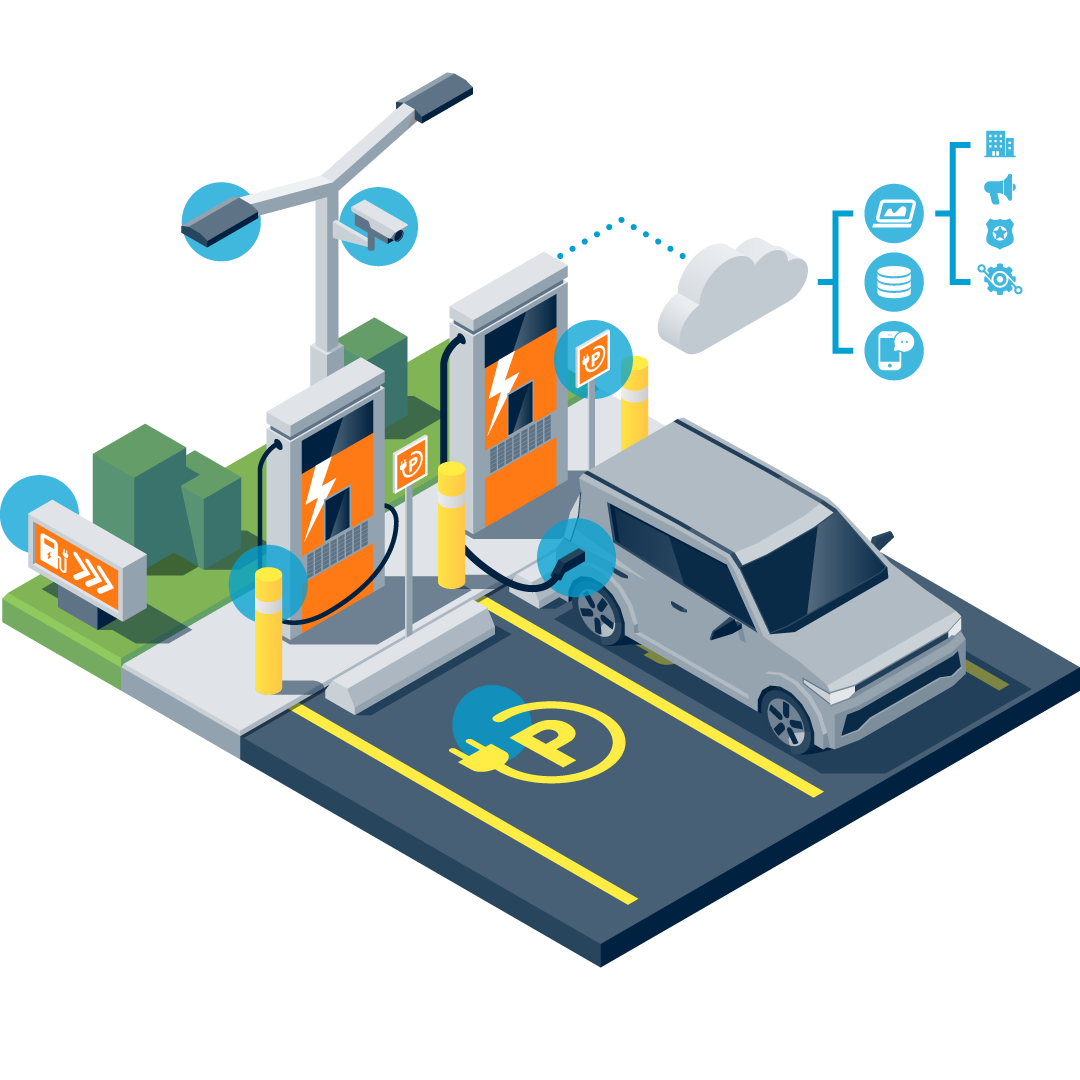Ev Charger Power Management for Auto Dealerships
The US government has laid out a plan to achieve net-zero emissions by 2050. The plan includes fleet electrification, with a mandate that EVs replace the government’s 650,000 vehicles. Federal and state governments are encouraging private companies to follow suit.
Electrification is the process of converting from internal combustion engine vehicles to electric vehicles (EVs). More companies are looking to electrify their fleets, and several major global enterprises have already converted. For example, Amazon plans to have 100,000 electric delivery vans in the US by 2030 and spend an additional $970 million on EVs in Europe. FedEx is working toward an all-electric pickup and delivery service by 2040. Pepsi and IKEA have made similar announcements regarding electrification of deliveries.


The Rise of EV Fleets
The push toward fleet electrification will affect companies of all sizes, not just the giants. In fact, more than 90% of fleets in the US have fewer than 25 vehicles. Fleets share similar challenges though. What is the cost of electrification? How will EV fleet vehicles charge? And what are the monetization opportunities of EV charging?
The EV charging solutions for your company depend upon your fleet’s unique purpose and needs. Your strategy shapes the revenue benefits of commercial chargers for EV fleets.
Where Can My EV Fleet Charge?
The push toward fleet electrification will affect companies of all sizes, not just the giants. In fact, more than 90% of fleets in the US have fewer than 25 vehicles. Fleets share similar challenges though. What is the cost of electrification? How will EV fleet vehicles charge? And what are the monetization opportunities of EV charging?
The EV charging solutions for your company depend upon your fleet’s unique purpose and needs. Your strategy shapes the revenue benefits of commercial chargers for EV fleets.
Does My Business Have the Infrastructure to Charge an Electric Fleet?
Few properties have the infrastructure to support level 3 chargers and will require an electrical upgrade, which could result in a two-year wait. Your current business use case may support level 2 EV charging for your fleet, but you may need fast charging in the future.
Future Energy has the subject matter experts to coordinate with utility companies to bring in adequate power for EV fleet charging. By thinking backward from a long-term view of your EV fleet, you can save money and aggravation.
How Does My Business Manage EV Fleet Power Requirements?
Fleet managers need a simple way to manage and monitor EV charging in real time. Future Energy utilizes a software called Interface, which gives visibility into fleet charging operations through a simple dashboard. Interface integrates all your EV chargers with the other smart systems on your property. As a result, you optimize EV charging costs and ensure predictable electric bills.

Cost Advantages to Public-Facing EV Fleet Chargers
For 64% of large-company fleet operators, lower total cost of ownership is the top motivation for fleet electrification
Cut Costs by Charging Your Own EV Fleets
Commercial EV charging heavily reduces fueling costs. This is especially true for medium- and heavy-duty fleets that have predetermined charging locations along fixed routes. For example, major municipalities can save up to 60% on fuel costs by electrifying buses and light-duty fleets.
Attract and Retain Customers
Depending on your business, you could benefit from opening your fleet’s EV chargers to the public when they’re not in use. Even free public chargers could be an indirect source of revenue.
Future Energy partner ChargePoint and a major retail chain conducted a pilot study that revealed the benefits of installing free level 2 charging stations:
- The average EV driver stayed at the retailer 50 minutes longer than the average customer.
- Shoppers spent approximately one dollar for each minute in the store.
- Revenue increased by $56,000 with just an additional $430 spent on electricity.
Of course, your business also can choose to ask patrons to pay for charging. Interestingly, British Petroleum says its network of DCFCs in the UK is nearing the level of profitability it sees from gas stations.
Improve Market Share
Even businesses that don’t depend on dwell time can see revenue benefits from commercial chargers for EV fleets. For example, car dealerships can use their inventory’s EV chargers to attract new clientele. EV chargers entice drivers of other brands to come to your dealership to charge. Your sales force has time to engage with these potential customers as they wait.
Similarly, office buildings can use EV chargers to attract tenants who need space where their fleets can charge. The installation of 480-volt electrical infrastructure to support level 3 charging can differentiate your property. Strategically, you can incorporate fleet EV charging costs into lease negotiations and in turn, tenants can offer EV charging as an employee benefit to recruit talent.

Cost Efficiencies Through EV Fleet Charging Solutions
EV charging for fleets is all about risk management. Public-facing EV chargers can drive significant revenue benefits and offset costs through available incentives. To offset risk, your EV chargers need to be available for your fleet vehicles as they need them.
Managing The Risk for Your EV Fleet
It’s critical to establish priority charging for the vehicles in your EV fleet. Using management software such as Interface, you can manage scheduling and reserve chargers for when your fleet vehicles need them. Future Energy consultants specialize in unraveling the complexities that public charging adds to EV charging strategy.
Capitalizing On Financial Incentives for EV Infrastructure
Future Energy’s Financial Incentive National Database tool helps our clients identify 99% of funding opportunities. You can stack federal, state, and local incentives to cover up to 100% of your EV installation cost in many cases.
For example, the National Electric Vehicle Infrastructure program designates $5 billion for states to invest in EV charging infrastructure. If you qualify within your state guidelines, your business can capitalize on these available funds and be integrated into the national plan for a network of EV chargers.
Exploring Future Revenue from EV Fleet Charging
By 2030, mass deployment of EV infrastructure could produce $15 billion in annual revenue and cost savings for businesses who invest in EV fleet charging solutions, McKinsey predicts. These cost benefits would come about in three primary ways:
- Purchasing renewable power from off-grid facilities
- Using stored power to recharge EV fleets at peak time-of-use hours
- Offering vehicle-to-grid services by selling stored power back to the grid

Help With Commercial EV Chargers for Fleets
The number one risk in the market today? Few experts to help your company manage risk for your EV fleet. Future Energy is ahead of the curve. Our consultants help identify your unique business use case, build strategy, and coordinate with the utility. Contact Future Energy today for help in understanding the revenue benefits of commercial chargers for EV fleets.
Solutions for an Evolving World


Future Energy’s complete, EV vehicle charging solution delivered as a turn-key environment.


Future Energy’s data visualization and management dashboard that connects all intelligent building systems.


Future Energy’s intelligent building systems solution that integrates your property’s lighting, climate, safety monitoring and more.
Rebates & Financial Incentives
We work with technology embedded hardware that involves aggressive government and utility tax credits, rebates and grants that drastically improve your cash flow. Contact us to find out what funding is available helping you choose the right hardware. Our team will work with you and the incentive program holders to get your application approved and processed quickly.













Let’s Connect
Designing smart building connectivity begins with a personal connection. We’ll discuss your goals, budget and timeline, and take it from there.
